Table of Contents
- Editor’s Choice
- Business Intelligence General Statistics
- Adoption Statistics of Business Intelligence
- Business Intelligence Statistics and Return on Investment (ROI)
- Cloud-based BI Statistics
- Top Business Intelligence Software Vendors Statistics
- Business Intelligence Statistics – Big Data
- AI & ML in Business Intelligence Statistics
- Business Intelligence Statistics – Future Trends
- Recent Developments
- Conclusion
- FAQ’s
Business Intelligence Statistics: Business Intelligence (BI) indicates technologies and strategies used by enterprises to manage business information and data analysis.
It is a batch of processes, technologies, and architectures that transform raw data into meaningful information.
This data can be used to mobilize fruitful business actions. Business Intelligence directly affects the strategic, tactical as well operational business decisions of an organization.

Editor’s Choice
- The Global Business Intelligence Market size is expected to be worth around USD 26.5 Billion by 2033, from USD 5.9 Billion in 2023, growing at a CAGR of 16.2% during the forecast period from 2024 to 2033.
- By 2023, over 33% of large-sized businesses will utilize decision intelligence practices.
- The global business intelligence and analytics market is expected to reach $55.48 billion by 2026, growing at a CAGR of 10.1% from 2021 to 2026.
- 94% of organizations rated business intelligence and analytics as either critical or very important to their business success. (Source: Dresner Advisory Services)
- Data-driven organizations are 23 times more likely to acquire customers, 6 times more likely to retain customers, and 19 times more likely to be profitable compared to their peers. (Source: McKinsey)
- About 97.2% of executives reported that their organizations are investing in or planning to invest in big data and AI to drive decision-making. (Source: NewVantage Partners)
- By 2022, 90% of corporate strategies will explicitly mention information as a critical enterprise asset and analytics as an essential competency.
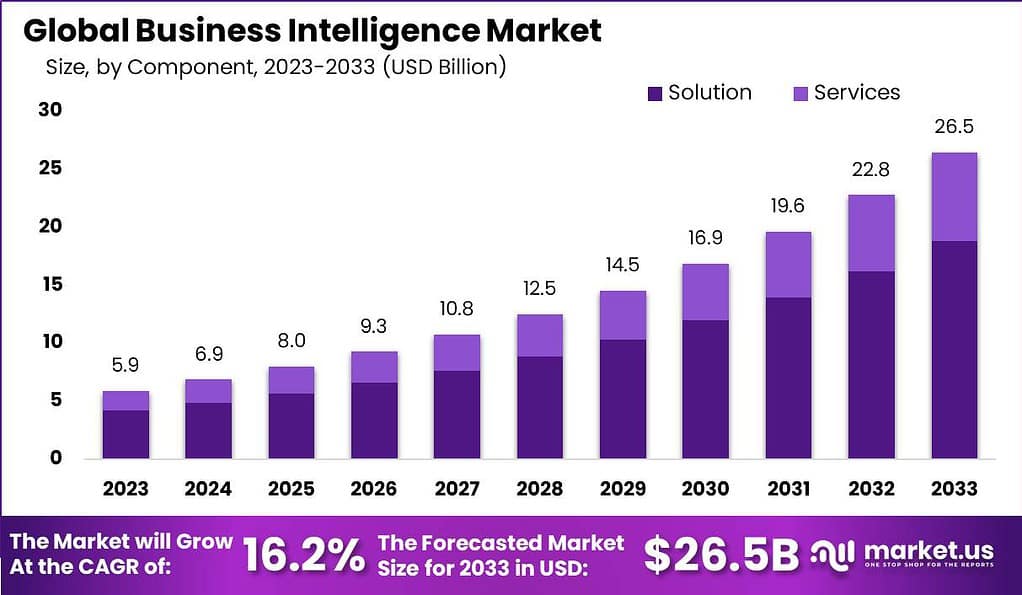
Business Intelligence General Statistics
- 83% of early AI adopters have achieved substantial (30% or more) or moderate (15% to 30%) economic benefits from their AI initiatives. (Source: Deloitte)
- About 70% of organizations consider themselves to be data-driven, and 75% believe that widespread data access is vital to their success. (Source: Tableau)
- Research by 3M Corporation suggests that visuals are processed 60,000 times faster in the brain than texts, highlighting the importance of data visualization in conveying information effectively. (Source: 3M Corporation)
- In 2020, 54% of enterprises agreed that cloud-based BI was vital to their current and future initiatives.
- According to business intelligence technologies, the popularity of BI has grown since 2012. Back then, only 10% of business owners considered it vital. By 2020, the percentage had almost tripled.
- The revenue for public cloud infrastructure will rise by 35% in 2021.
- Over 30% of institutions in higher education thought cloud BI was critical in 2020.
- 70% of organizations think that data discovery and visualization are vital.
- The market value for applications in business intelligence was $17.7 billion in 2020. (Source: Tech Jury)
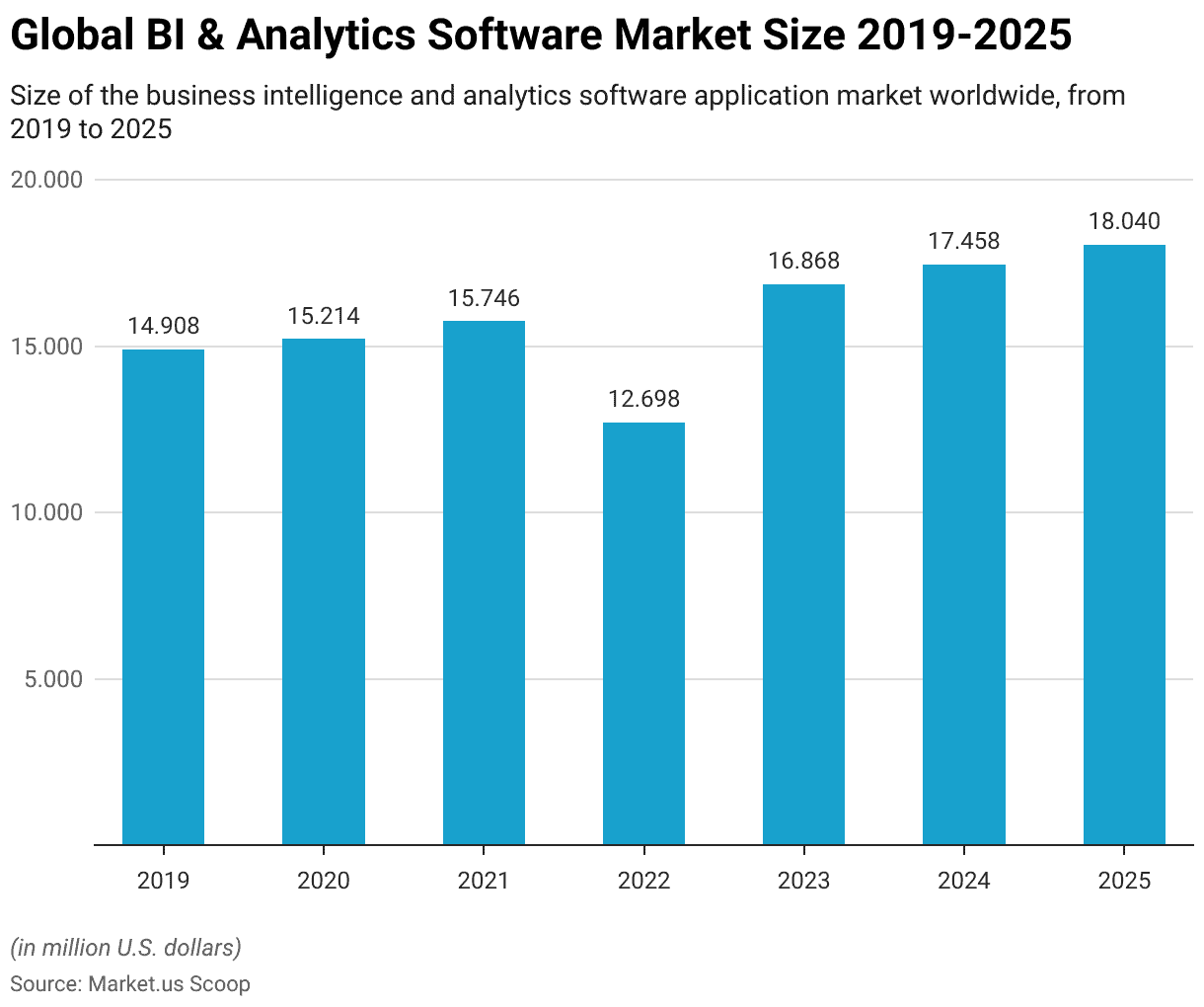
Adoption Statistics of Business Intelligence
- In 2020, 54% of enterprises agreed that cloud-based BI was vital to their current and future initiatives. (Source: Forbes)
- According to business intelligence technologies, the popularity of BI has grown since 2012. Back then, only 10% of business owners considered it vital. By 2020, the percentage had almost tripled.
- Covid-19 propelled a higher adoption rate of BI in 2020. (Source: Analytics Insight)
- A third of large-scale organizations will adopt decision intelligence by 2023. (Source: Information Week)
- Data analytics makes decision-making 5x faster for businesses. (Source: Better Buys)
- Record-keeping organizations (financial institutions, higher education, retail companies, etc.) are the major industries leveraging cloud business intelligence today. (Source: Learn G2)
- The revenue for public cloud infrastructure will rise by 35% in 2021. (Source: Server Space)
- Over 30% of institutions in higher education thought cloud BI was critical in 2020. (Source: Forbes)
- 70% of organizations think that data discovery and visualization are vital. (Source: BI Survey)
- The market value for applications in business intelligence was $17.7 billion in 2020. (Source: Select Hub)
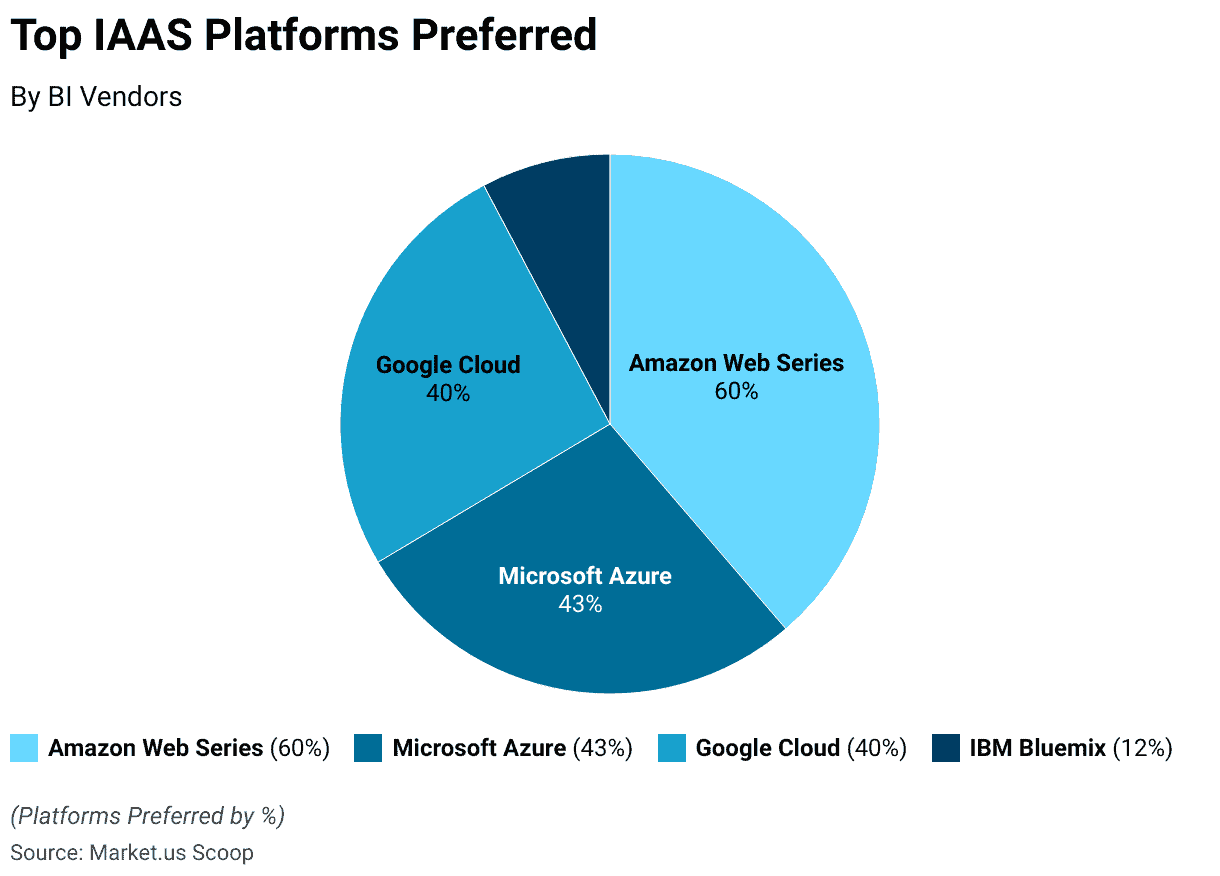
Business Intelligence Statistics and Return on Investment (ROI)
- Implementation of a BI solution can result in a 127% return on investment (ROI) in three years. (Source: Tableau)
- Business analytics yields an average ROI increase over five years, with an average payback of 1.6 years for every $4.5 million spent.
- In 2019, 91.6% of global companies increased their investments in big data and AI. In 2020, only 51.9% accelerated their rate of investment. (Source: NewVantage Partners)
- Poor data quality costs the US economy approximately $3.1 trillion annually. (Source: IBM, 2020)
- Business intelligence, big data, and analytics are the top disruptive technologies employed by Global 2000 organizations. (Source: TCS)
- All previously on-premise-only BI vendors now offer cloud BI deployment options, but not all offer on-premise deployment. (Source: Forrester, 2019)
- In 2020, the United States faced a shortage of 250,000 people with analytical data skills. (Source: QuantHub, 2020)
- CIOs experienced a skills shortage, with 46% facing a shortage of data analytics skills and 38% facing a shortage of AI skills. (Source: KPMG, 2019)
More Business Intelligence ROI
- The US Bureau of Labor Statistics predicts the creation of around 11.5 million data scientist jobs by 2026. (Source: Data Flair, 2019)
- Finance and insurance, professional services, and IT sectors account for 59% of data science and analytics job demand. (Source: IBM, 2021)
- Demand for data engineers is projected to grow at a rate of 50% annually.
- Data science and analytics jobs remain open for an average of 45 days, five days longer than the market average.
- It takes 53 days to fill the position of an analytics manager in professional services, making it one of the most difficult positions to fill.
- Demand for data engineers saw a 45% increase in 2020. (Source: Hired, 2020)
- The demand for data science and machine learning jobs is expected to grow by 38% and 37% over the next decade, respectively. (Source: Dice, 2020)
- Data engineers in the San Francisco Bay Area enjoyed a 6% salary boost, averaging $160,000 per year in 2019. (Source: Hired, 2020)

Cloud-based BI Statistics
- The global cloud-based business intelligence (BI) market is expected to reach $15.2 billion by 2026, growing at a CAGR of 22.8% from 2021 to 2026.
- In 2020, 59% of organizations reported using cloud-based BI platforms for data analysis and reporting, representing a significant increase from previous years. (Source: BARC Research)
- Cloud-based BI solutions offer an average time-to-deployment of 3-4 months, compared to on-premise solutions which typically take 12-18 months to implement.
- 80% of organizations using cloud-based BI experienced improved scalability, enabling them to handle larger volumes of data and accommodate growing user bases. (Source: Dresner Advisory Services)
- Cloud-based BI platforms offer cost advantages, with lower upfront investments and reduced maintenance costs compared to traditional on-premise solutions.
- According to a survey, 88% of organizations using cloud-based BI reported increased flexibility in accessing and analyzing data from anywhere, anytime. (Source: MicroStrategy)
- The cloud-based BI market is driven by the increasing adoption of Software-as-a-Service (SaaS) solutions, which accounted for the largest share of the market in 2020.
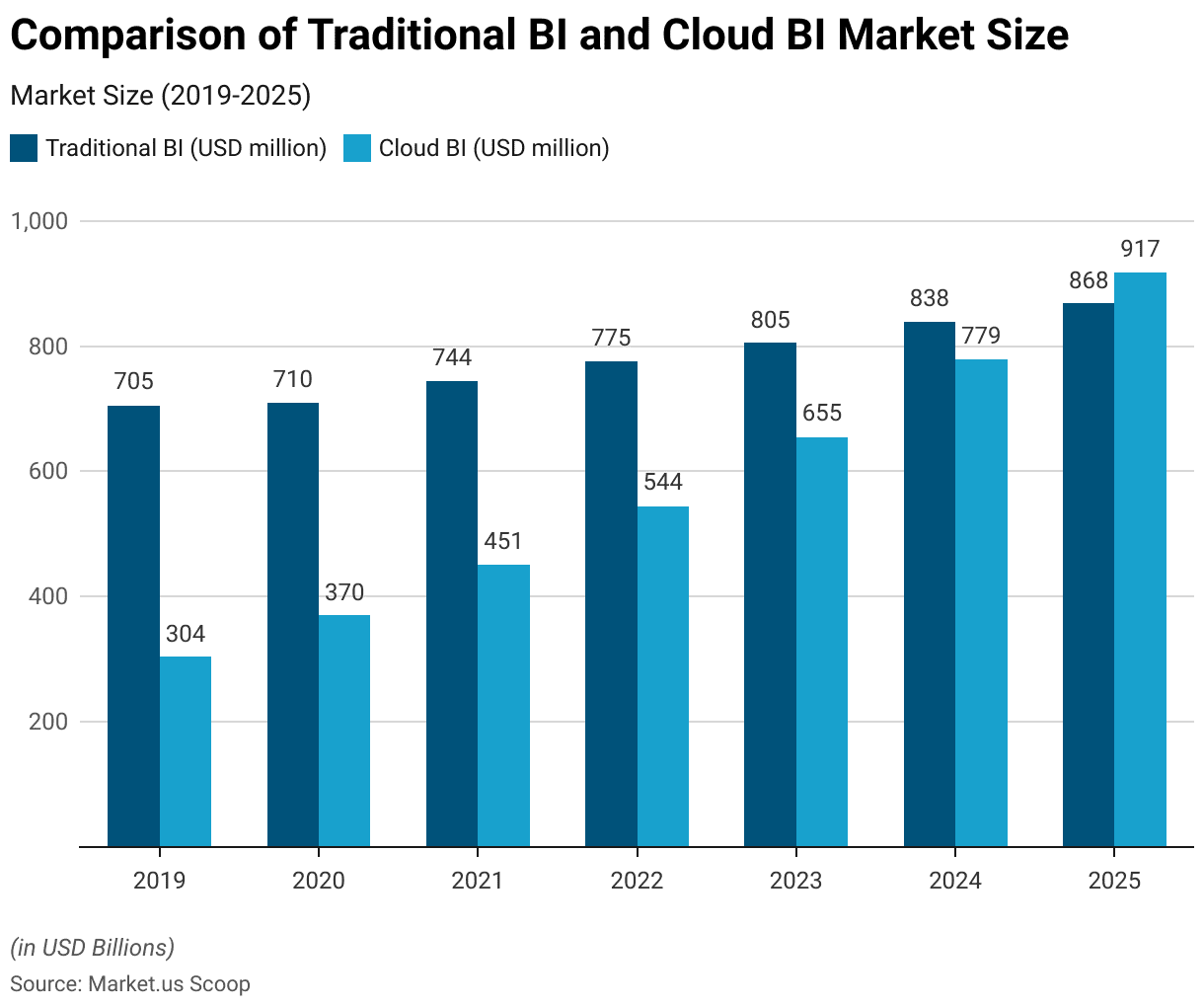
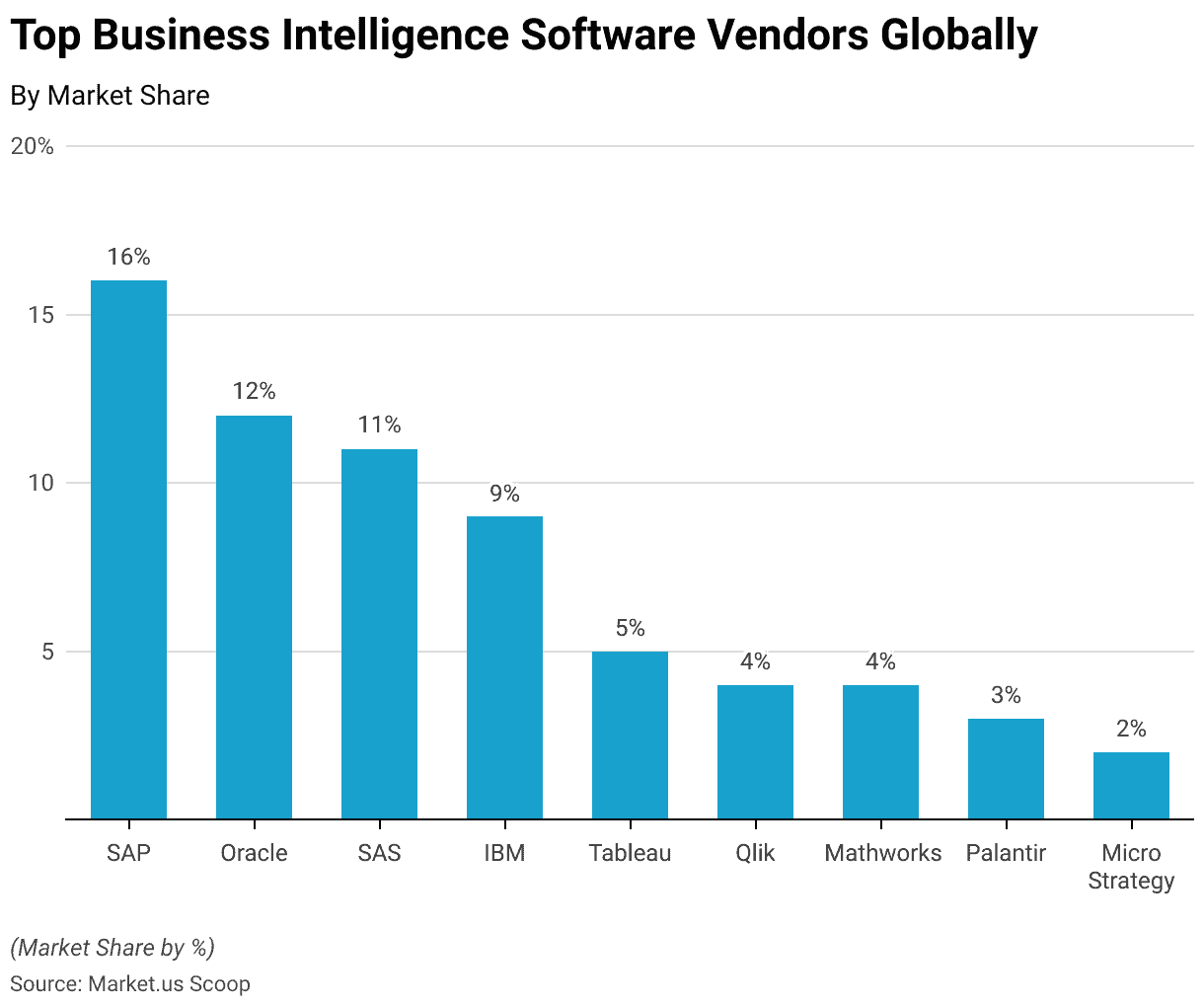
Top Business Intelligence Software Vendors Statistics
Microsoft Power BI
- Power BI has experienced significant growth in market share over the years. As of 2021, it holds a market share of over 30% in the analytics and business intelligence platforms market.
- According to Microsoft’s official reports, Power BI has surpassed 100,000 organizations as customers, indicating its widespread adoption across various industries.
- Power BI has a large and growing user base. As of April 2021, Power BI has over 30 million active monthly users. (Source: Microsoft Power BI Blog)
- Microsoft Power BI has a 13.74% market share in the same space. (Source: Sense)
Tableau
- Tableau has been recognized as one of the leading vendors in the business intelligence and analytics market.
- In 2021, Tableau had a market share of approximately 16.99% in the business intelligence space.
- As of 2021, Tableau has over 100,000 customer accounts worldwide. (Source: Tableau official website)
- Tableau Software has a market share of 16.99% in the data visualization market. Tableau Software competes with 231 competitor tools in the data visualization category. (Source: Sense)
Qlik
- Qlik is recognized as a major player in the business intelligence and analytics market.
- According to the research for Analytics and Business Intelligence Platforms in 2021, Qlik was positioned as a leader in the market.
- Qlik’s comprehensive suite of products, including Qlik Sense and QlikView, has gained popularity among organizations seeking robust data visualization and analytics capabilities.
- As of September 2021, Qlik reported having over 50,000 customers worldwide, including both large enterprises and small to mid-sized businesses.
- Qlik has a market share of 4% in the business intelligence industry. (Source: Truelist)
SAP
- SAP is one of the largest enterprise software companies globally and has a strong market presence.
- As of 2021, SAP has over 400,000 customers in more than 180 countries. (Source: SAP)
- SAP generates significant revenue from its software solutions and services.
- In 2020, SAP reported a total revenue of €27.34 billion (approximately $32.58 billion). (Source: SAP)
- SAP’s cloud revenue reached €8.09 billion (approximately $9.64 billion) in 2020, representing a 17% increase compared to the previous year. (Source: SAP)
- SAP has a substantial employee base, supporting its global operations and customer base.
- As of the end of 2020, SAP had approximately 103,142 employees worldwide. (Source: SAP)
- SAP Business Objects has a market share of 20.49% in the analytics-and-bi-platform market. (Source: Sense)
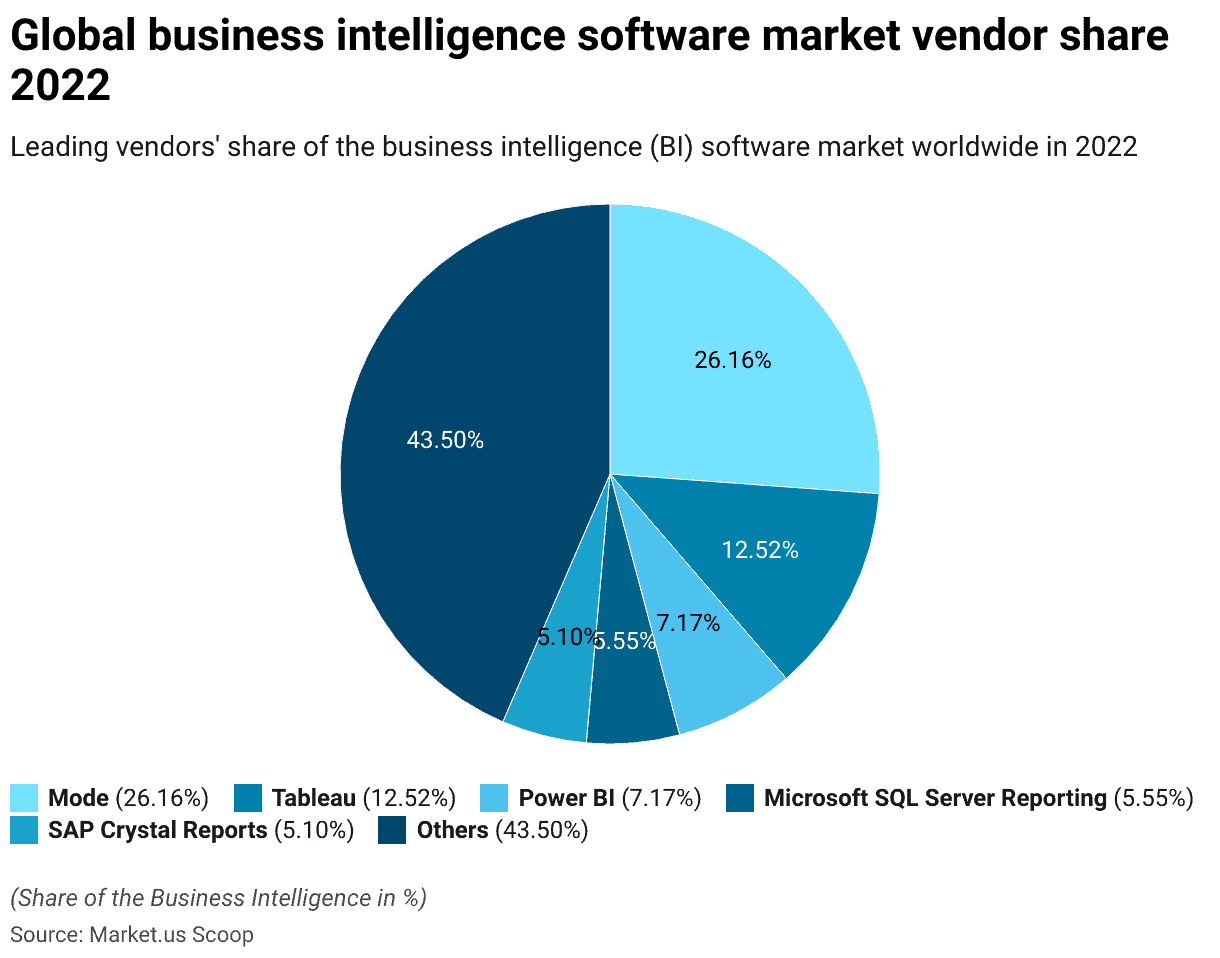

Business Intelligence Statistics – Big Data
- The volume of data generated worldwide is growing exponentially. It is estimated that by 2025, the total volume of data will reach 175 zettabytes (1 zettabyte equals 1 trillion gigabytes). (Source: IDC)
- The number of connected IoT devices is also increasing rapidly, contributing to the growth of Big Data. It is projected that there will be around 41.6 billion IoT devices by 2025. (Source: Statista)
- According to a survey conducted in 2021, 95% of business professionals agreed that analytics is important for their organization’s future success. (Source: MicroStrategy)
- The global BI and analytics market size is expected to reach $84.6 billion by 2026, growing at a CAGR of 14.7% from 2021 to 2026.
- BI can lead to cost savings and revenue growth. According to a study, companies using BI experienced an average ROI of 112% and a payback period of 1.6 years. (Source: Nucleus Research)
- A study found that organizations with high BI adoption rates are 5 times more likely to make faster and better-informed decisions. (Source: Aberdeen Group)
- A survey revealed that the top challenges in implementing Big Data initiatives are data quality and accuracy (40%), data integration (39%), and data security and privacy (34%). (Source: NewVantage Partners)
- Organizations also struggle with a shortage of skilled data professionals. By 2025, it is estimated that the shortage of data professionals will reach 4.3 million worldwide. (Source: IBM)
- AI is playing a crucial role in enhancing BI capabilities and enabling advanced analytics and automation.
- By 2025, it is estimated that 75% of enterprise applications will incorporate AI, including AI-driven analytics and decision support systems. (Source: IDC)
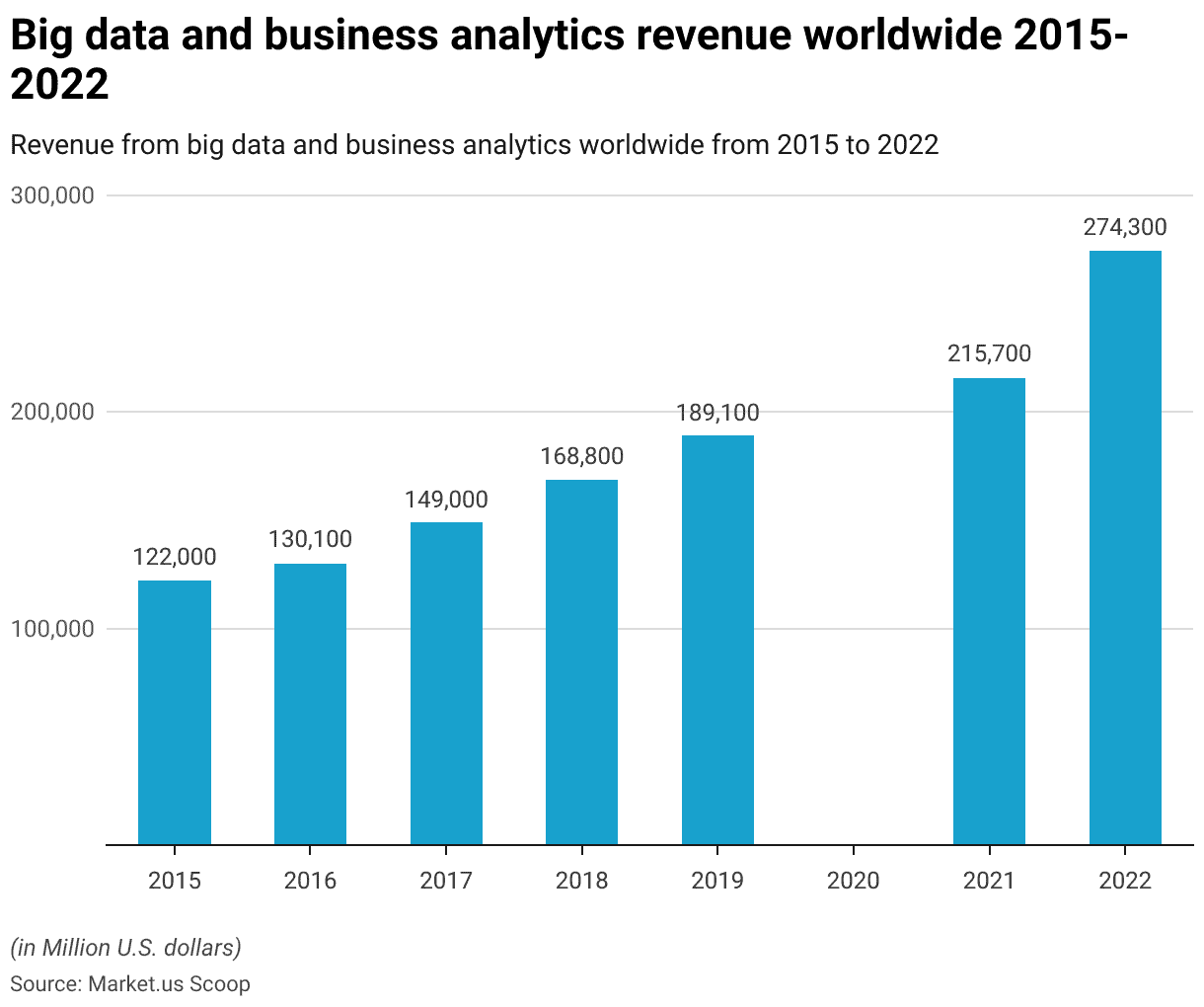
AI & ML in Business Intelligence Statistics
- According to a survey, 54% of business intelligence professionals have already implemented AI or ML technologies in their BI initiatives, while an additional 25% plan to implement them within the next three years. (Source: BARC BI Trend Monitor 2021)
- The same survey indicates that 89% of respondents consider AI and ML to be important or very important for the future of BI.
- NLP and AI-powered analytics enable users to interact with BI systems using natural language queries and receive meaningful insights.
- By 2023, it is estimated that NLP and conversational analytics will be a standard feature in 50% of modern BI and analytics platforms.
- According to data, by 2023, 50% of new data preparation tools will include AI algorithms for suggesting transformations and automating manual tasks.
- According to a study, 73% of organizations have already implemented or are planning to implement AI for predictive analytics within the next two years.
- By 2025, AI-powered augmented analytics will be a dominant driver of new purchases of analytics and business intelligence tools, reaching 40% of new deployments.
- By 2023, 30% of organizations will use AI for proactive detection of security incidents in their data, up from less than 10% in 2020.
Business Intelligence Statistics – Future Trends
- By 2023, 50% of analytics queries will be generated using search, natural language processing, or voice, and embedded analytics capabilities will be a key driver in delivering insights within the context of business applications.
- By 2024, organizations that offer users access to self-service analytics will generate more than twice the business value from their analytics investments than those that do not.
- By 2024, 75% of organizations will rely on business intelligence and analytics solutions delivered through the cloud, up from 45% in 2021.
- By 2023, organizations that have fully invested in data governance will outperform their peers financially by 20%.
- By 2025, 70% of organizations will leverage real-time analytics for insights and decision-making, up from 40% in 2020.
- By 2023, organizations that promote data democratization will outperform their peers on key business value metrics by at least 20%.
As compared to men, 34% of Business Intelligence Analysts are women.
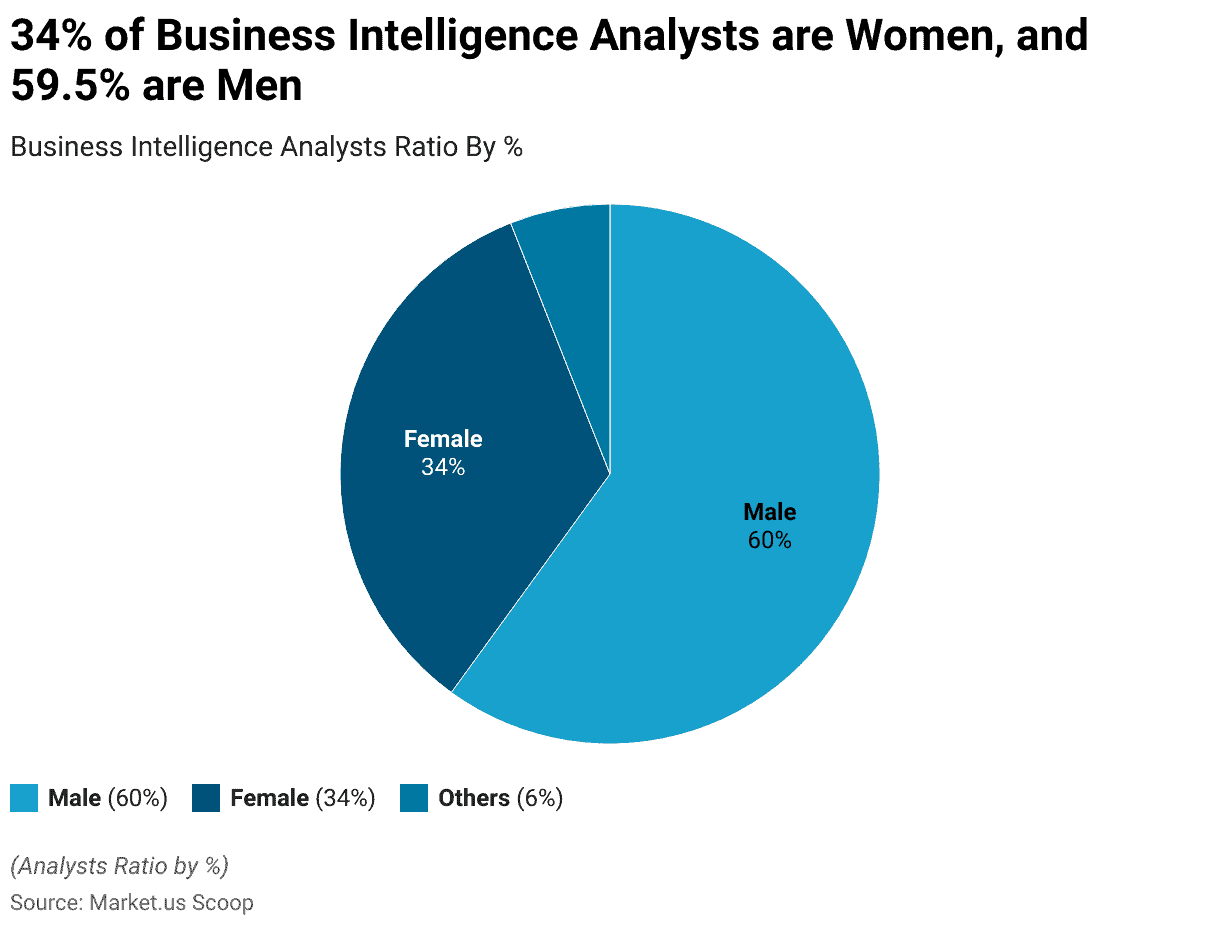
Recent Developments
Acquisition: Microsoft Acquires C3.ai for $6.9 Billion
- Microsoft, a leading technology company, completed the acquisition of C3.ai, a prominent provider of enterprise artificial intelligence (AI) and predictive analytics software, for a substantial $6.9 billion.
- This strategic move aims to strengthen Microsoft’s position in the business intelligence and data analytics market.
Merger: Salesforce and Tableau Merger Completes Integration
- Following the acquisition of Tableau by Salesforce in 2019, the companies have successfully integrated their operations and product offerings.
- This merger combines Salesforce’s customer relationship management (CRM) platform with Tableau’s powerful data visualization and analytics capabilities, enhancing the business intelligence solutions available to customers.
New Product Launch: Google Cloud Unveils BigQuery Omni for Multi-Cloud Analytics
- Google Cloud introduced BigQuery Omni, a groundbreaking solution that enables organizations to analyze data across multiple cloud platforms seamlessly.
- This innovative product launch empowers businesses to harness the power of data analytics regardless of their cloud provider, fostering agility and flexibility in decision-making processes.
Funding: Snowflake Raises $1.1 Billion in Series H Funding Round
- Snowflake, a leading cloud data platform, secured an impressive $1.1 billion in its Series H funding round, further solidifying its position as a key player in the business intelligence and data warehousing market.
- This substantial investment underscores growing investor confidence in Snowflake’s innovative data management solutions.
Strategic Partnership: IBM and Palantir Collaborate on AI-Driven Data Analytics Solutions
- IBM and Palantir Technologies announced a strategic partnership aimed at delivering AI-driven data analytics solutions to enterprises across various industries.
- This collaboration leverages IBM’s expertise in cloud computing and AI technologies alongside Palantir’s advanced data integration and analysis capabilities, offering comprehensive business intelligence solutions to clients.
Expansion: Tableau Expands Presence in Asia-Pacific Region with New Offices
- Tableau, a leading data visualization software company, expanded its footprint in the Asia-Pacific region by opening new offices in key markets such as Singapore and Hong Kong.
- This expansion initiative aims to cater to the growing demand for business intelligence and analytics solutions in the region, strengthening Tableau’s global presence.
IPO: Databricks Files for Initial Public Offering (IPO)
- Databricks, a data analytics and AI platform provider, filed for its much-anticipated initial public offering (IPO), signaling its readiness to become a publicly traded company.
- This move reflects investor confidence in Databricks’ innovative approach to data management and analytics, paving the way for potential growth opportunities in the business intelligence market.
Conclusion
Business Intelligence Statistics – Business Intelligence (BI) plays a crucial role in enabling organizations to leverage data for informed decision-making.
With the advancements in technology and the increasing volume of data, BI has evolved to incorporate artificial intelligence, machine learning, and augmented analytics.
These trends are driving the future of BI, offering organizations opportunities for automation, self-service capabilities, real-time insights, and improved data governance.
Embracing these trends and harnessing the power of BI empowers businesses to gain deeper insights, drive innovation, and stay competitive in today’s data-driven landscape.
Take advantage of our unbeatable offer - buy now!

By leveraging BI effectively, organizations can unlock the full potential of their data and make strategic decisions that propel their success.
FAQ’s
Business Intelligence refers to the process of collecting, analyzing, and presenting data to gain insights and support informed decision-making within an organization. It involves technologies, tools, and methodologies to transform raw data into actionable intelligence.
The global business intelligence and analytics market was valued at $23.9 billion in 2020 and is projected to reach $55.48 billion by 2028, growing at a CAGR of 10.1%.
As of 2021, Microsoft Power BI holds over 30% market share, followed by Tableau with approximately 19% market share, and Qlik with around 10% market share.
In 2020, the world generated 64.2 zettabytes (1 zettabyte = 1 trillion gigabytes) of data, and this number is projected to reach 181 zettabytes by 2025.
Discuss your needs with our analyst
Please share your requirements with more details so our analyst can check if they can solve your problem(s)



